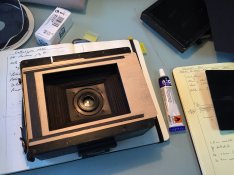Simon Howers
Member
1) Busy making a prototype paper neg holder for my quarter plate camera. Using a commercial tin darkslide for the prototype.
The focal plane is some 6mm above the rear flange on the camera so I've currently got some 2.5mm to play with. I can either stretch the neg bare across the window in the holder or I can install a 2mm glass plate to create a sandwich. I understand that the glass option was how this was originally done, with the neg between the glass and a backplate.
Any views or suggestions?
2) Nowadays, does anybody use Gallic Acid in any part of the process? There seems to be a body of thought that it can be used at the end of development to enhance the blacks.
The focal plane is some 6mm above the rear flange on the camera so I've currently got some 2.5mm to play with. I can either stretch the neg bare across the window in the holder or I can install a 2mm glass plate to create a sandwich. I understand that the glass option was how this was originally done, with the neg between the glass and a backplate.
Any views or suggestions?
2) Nowadays, does anybody use Gallic Acid in any part of the process? There seems to be a body of thought that it can be used at the end of development to enhance the blacks.








 )
) )
)